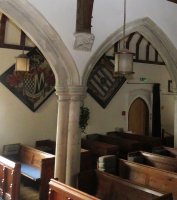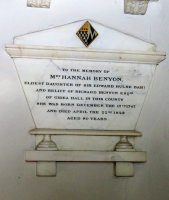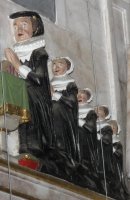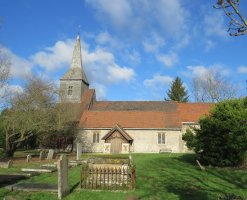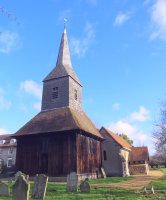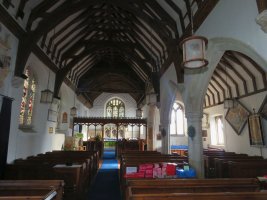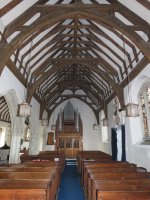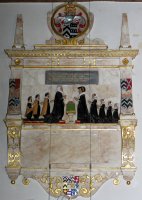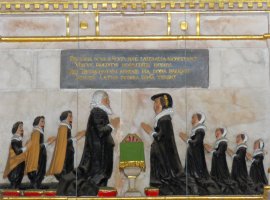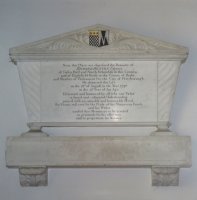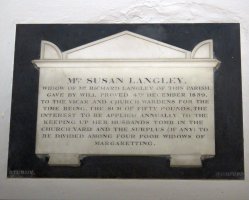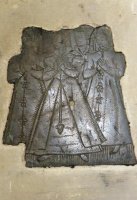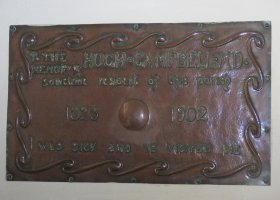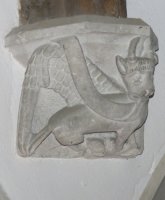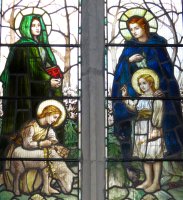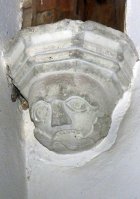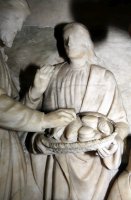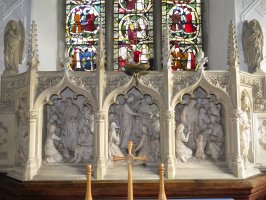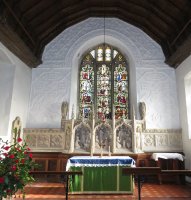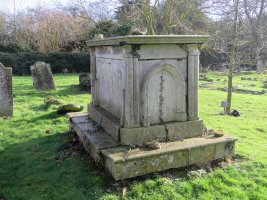Margaretting Church, Essex - Monuments
Margaretting Church is a small, evocative Essex church with a wooden tower with broach spire, dating mostly from the 14th and 16th Centuries; it contains a few monuments, a very good brass, and a reredos by Thomas Earp.
Margaretting Church.
St Margaret of Antioch Parish Church, Margaretting, Essexis built of stone, rubble, flint, a few Roman tiles, with terra cotta-tiled roofs, several of them, most picturesque. The west tower though and its surround are of wood, of modest height, shingled and with a broach spire. There are not so many of these distinctive wooden towers. To the south side is the single aisle, with a modest porch, again with a little roof of its own; there is another porch to the north side. What are we seeing? Mostly around 1400 or thereabouts, with the tower a bit later along with the north porch, and the south porch from a 19th Century restoration. There is a bit of Norman work to the north side of the nave. The windows date from the 15th and 16th Centuries, and 19th Century.
Interior views of Margaretting Church.
Inside, we see the relative breadth and height of the south aisle, with high-cut arches, so the interior is lighter and more spacious seeming than the visitor might expect from the outside. Dark pews. and many beams above, whitewashed walls and a delicate wooden screen to the chancel. We have just half a dozen stone monuments, but one of them is an interesting kneeler monument of the 16th Century, there is an ancient brass and two Arts and Crafts ones, and several hatchments and other things give variety and atmosphere.
Monuments
William Tanfield, and his wife Elizabeth Tanfield, 1625. A kneeler monument, on a modest scale, carved in high relief. We see the couple in the usual kneeling, praying pose, facing each other across a little prayer desk covered with a hanging cloth. Their children are lined up behind them: three bearded men behind their father, and four daughters behind the mother, miniature replicas except that the parents have proper ruffs, and the girls have bonnets rather than the hat of their mother. They kneel on small cushions. To the outside, four painted shields of arms on pilasters supporting a canopy, with large coat of arms in a roundel at the top, and a bit of strapwork, and obelisks resting on balls to the sides, all quite usual. There is a short Latin inscription above the figures, but the main inscription on the deep panel below is lost. Brackets to the sides of that, decorated with low relief carvings of flowers, scrolling and crosses, all quite simple, and at the base, a curly apron with further leafy scrolling and a painted shield of arms. In nice pinking alabaster, with the figures rather crudely painted in a modern restoration, though presumably replicating a previous similar coating. Lots more kneeler monuments on this page.
Richard Benyon, d.1774, of Gidea Hall, near Romford, twice Governor of Fort St George in the East Indies, noting that he was thrice married, and his third wife, [unnamed here, but Mary [Tyssen] Wrighte], was the widow of Powlett Wrighte of Englefield House, Berkshire. Benyon was an important figure in the East India Company. The monument is styled as a neat casket tomb; thus with outward leaning sides to the inscribed panel, and a lid above, carved in relief with crossed branches and a painted shield of arms; it rests on little feet with mouldings, standing on a thick lower shelf, itself supported on two brackets carved with acanthus leaves.
Richard Benyon, d.1796, and Susan Langley, d.1839.
Richard Benyon, d.1796, of Gidea Hall and North Ockenden, and of Englefield House in Berkshire, MP for Peterborough, and son of the above. The monument replicates the design of that of his father, and the sculptor was Richard Westmacott the Elder (see this page. Picture above left.
Hannah [Hulse] Benyon, d.1828, wife of Richard Benyon and daughter of a baronet. Another casket tomb, simpler and lighter weight than that of her husband, with just the painted sield of arms on the pediment, feet, and the simplest of shelves supported on little blocks below. See picture at top of page.
Sarah Christian Jesse, d.1833, her father the Revd. William Jesse, d.1858, Vicar of the Church, and his wife Sarah Jesse, d.1872, with an entirely Latin inscription, really rather unusual at this late date. Plain white panel on a black backing, with meagre supports.
Susan Langley, d.1839, who left £50 to generate interest for the upkeep of the tomb of her husband, Richard Langley, in the churchyard, with the surplus (if any) to be divided among four poor widows of Margaretting. A simple tomb chest design, with upper blank pediment above a lip rather than an entablature, and little feet below, on a black backing, signed by a local stonemason, Sturdy of Romford - see picture above right.
William and Elizabeth Tanfield, early 17th Century.
Brasses:
Ancient brass: It consists of separate figures of a man, his wife, their children beneath, and shield of arms above, and set in a modern stone panel cut as a three headed window; originally of course it would have been a rectangular slab. The figures are fine, though he has lost his head. They stand a little turned towards each other, and her head is turned entirely towards her husband; his surviving beard suggests a three-quarters view, aligned with his body. He wears plate armour and stands with his sword behind him, the scabbard almost down to the grass. She wears a long robe, open at the front to show a furry skirt on which rests her little purse; she has a fur collar too, puffed shoulders, and wears a bracelet. Her face is long, slender, and she has a headpiece with hanging veil at the back. Really very good work. Beneath the father, their three sons, in lighter costume with tunics and robes, much simpler in artistic treatment. And beneath the mother, four daughters with spread out skirts, she at the front with a purse, the two flanking and behind her with their cloaks closed by little flower buttons. Their pose and positioning is rather different from older brasses, which would typically have the offspring in a line rather than one to the front, as here. According to the Royal Commission on Historic Monuments, this brass dates from c.1450; other respectable sources say it is Robert Sedge and family, 16th Century, who lived in Shenfield House [later Killigrews].
There are two interesting Arts and Crafts coppery brass panels: to Hugh Capbell, d.1902, with a nice wiggly repeating border which on close examination seems to be snakes swallowing each other’s tails; and to his wife Henrietta Campbell, d.1912, embossed and with a figure group of mother with children under trees above the inscription. There is also a plain 20th Century panels to their son, Harry Campbell, d.1938.
Hugh Campbell, d.1902, brass.
Thomas Hills Christy, d.1918, killed in action. A modern brass typical of a type popular from late Victorian times, capitalised with red capitals, and a border with a repeating design, here of stylised oak leaves and acorns, with crosses at the corners.
There are further plain brass panels to Vivien Irene Stranack, d.1944, killed by enemy action, with an italic font, to Lt. Richard Algar Adams, d.1944, killed in action, Robert (Bob) McGowan, d.1944, killed in action, to a recent Vicar, the Revd. George Behr, d.1949, and to Stanley Cornwallis Poits, d.1979.
Brass and details, 15th or 16th Century.
Also in the Church:
Supporting the main roofbeams are carved corbels, emblematic of the evangelists (eagle, winged bull etc) and grotesque heads; presumably 15th or 16th Century, though looking somewhat restored or recurved in parts.
The font, an octagonal one with single thick support, carved with simple geometric designs, and tudor rose etc, late 15th Century apparently.
Several floor slabs from the 17th Century.
One bit of the plaster is scraped away to show a bit of coloured wall patterning underneath.
The screen, thin and delicate, with central door and four bays to each side, 15th Century below, with the tracery above being modern (as a memorial to the Great War).
Pulpit, in stone, with blind Gothic windows and two well carved supporting female figures with long robes standing on rush mats; late Victorian.
Sculptor Thomas Earp's reredos, and details.
Reredos, a Gothic effort with crocketed windows and lots of figure sculpture within: it depicts the Feeding of the Five Thousand with Loaves and Fishes, and we see a range of Biblical figures passing out more loaves and less fishes to various kneeling and standing people. Enlivened with good poses and grouping of the figures. To the sides, blind windows with standing figures: left side - St Margaret of Antioch, standing on her symbol, a dragon; to the right, a saint holding a book in one hand - the other is gone - perhaps St Paul. Free standing angels above. By the sculptor Thomas Earp, 1877. He specialised in Gothic-style church sculpture of this sort; his most well known work is the Eleanor Cross in front of Charing Cross Hotel by Trafalgar Square. A panel below notes the wooden dado was designed and carved by members of the Margaretting Village Carving Class, 1893-96.
Austere World War I memorial panel, stone, with pilasters, upper and lower shelf, and supporting brackets. Outside, there is a Celtic cross war memorial; one of the fallen is recorded as the Thomas H. Christy whose plain brass is noted above, and another, Herbert Horsley, may be the H. Horsley recorded as one of the members of the Village Carving Class mentioned above.
Three Hatchments (see picture at top of page), two of them next to one another, with between them a drapery of Margaret of Antioch by the Mothers Union.
Decorative Plasterwork, quite ornate, covering the whole of the east wall of the Chancel, with low relief strapwork patterning, and two figure scenes, low relief, 1918; the artist was Philip Robson.
Plasterwork, Tree of Jesse window.
Stained glass - the East window (3 lights) is a Tree of Jesse, and apparently 15th Century Flemish glass - David is at the base, and the Virgin and Child at the top. There are several windows of 19th/early 20th Century stained glass, with ornate foliage detailing; note especially the window to Eleonora Hughes, d.1902, with the figures and trees very much in the Arts and Crafts idiom (see picture a little further up).
Outside, the Churchyard contains mostly simple headstones and several great slabs; there are a couple of large chest tombs, hopefully one being that to Richard Langley, given the funds given by his widow to preserve it.
The Church details can be found at https://www.achurchnearyou.com/church/6330/.
Another Essex church with a broach spire is Lambourne Church, on this page, and another is Shenfield Church. Westward are the churches of Essex in London: see this page.


